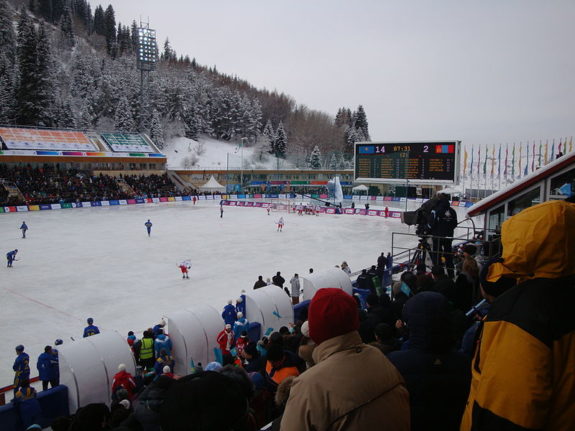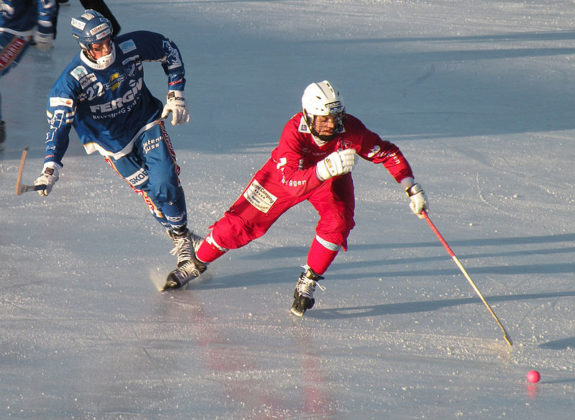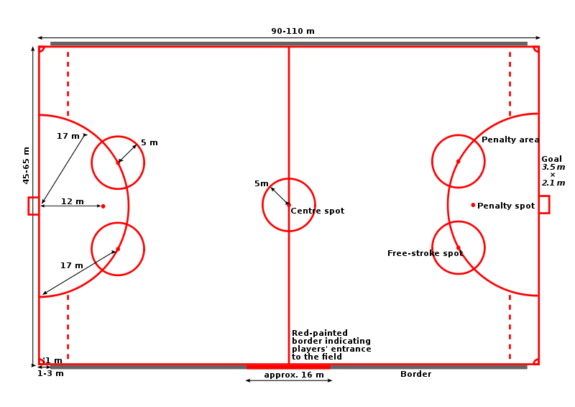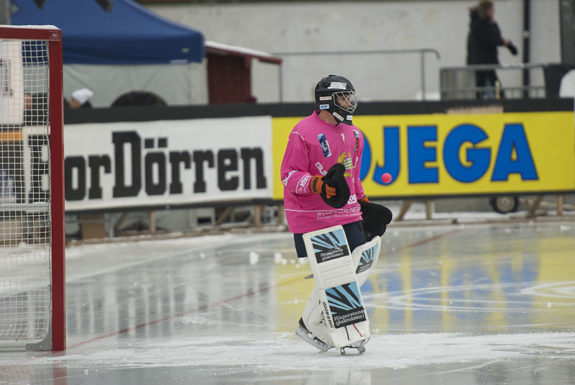The sound of blades grinding the ice of players skating at high speeds, blistering 100+ MPH slap shots, beautiful end-to-end rushes with tape-to-tape passes, and sprawling kick saves by goaltenders are major components of the great game of bandy.
Most people: “Wait what? You mean hockey.”
No, I mean bandy.

Bandy is an incredibly skillful and fast-paced game played on an extremely large ice rink primarily in northern Europe and Russia. To someone who knows little about hockey, bandy can easily be mistaken for it and is even known as hockey in some remote locales in Finland and Sweden. Bandy has also been coined “Russian Hockey” as early versions of the game were played in northern areas of Russia. Although extremely popular overseas, bandy is often overlooked or never even heard of by many North American sports aficionados due to the more widely played game of ice hockey.
However, every hockey fan and player should check this game out at least once in their lifetime. My bucket list now includes playing a pickup game of bandy after watching a professional game live while on a trip in Sweden.

Bandy and ice hockey share common historical ancestry. These two games diverged into two distinct sports throughout the 19th century with ice hockey developing in Canada and bandy formalizing in England.
Late in the 19th century, English football was rapidly growing in popularity in Britain, with new clubs forming every year. A number of these clubs decided to start playing the casual winter sport of bandy to stay conditioned and have a little fun. As more teams began competing with each other, the need for universal rules became apparent.
Since a majority of the bandy teams were primarily English football clubs, the formalized Bandy rules were heavily influenced by the rules of English football. The size of the rink, also known as the pitch, is equivalent to the size of a soccer field which is approximately 350 feet long by about 180 feet wide. There are shortened boards that surround the rink, but they go beyond the out-of-bounds line, so the ball (they do not use a puck) can go out of bounds just like in soccer. Also like soccer, the game time is 90 minutes long and is broken into 45-minute halves.

Since bandy was based on English football rules, the positions are the same as soccer, with one goalie and 10 skaters consisting of defenders, midfielders, and forwards. Generally, there are three or four backup players on the bench, who unlike in soccer and similar to hockey, can substitute regularly throughout the game to give starting players rest. All skaters use bandy sticks, which are shorter than hockey sticks in both the height of the stick (no longer than 127 centimeters or 50 inches) and in the length of the blade (no wider than 7 centimeters or 2.8 inches). Bandy, a Welsh word meaning “a curved stick,” does not allow flat blades as sticks are crooked and offered in five angles, from a slight bend to a large bend.
Since there are no blue lines, the offsides rule is—once again—similar to soccer. That means an attacking player cannot skate behind the last opposing defender (not including the goalie) unless they are carrying the ball. If a pass is directed towards that player, they must be either in front of or parallel to the last defender when the ball leaves the stick of the attacking player’s teammate in order to be onside. This makes breakaways near impossible and puts greater emphasis on dangling and passing to get around the opposition.
One major difference to North American ice hockey is bandy’s emphasis on speed rather than physicality. Body checking and fighting are not allowed and both will result in penalties being called. If the physicality of the game is the sole reason why you like hockey, bandy is most likely not the sport for you. Players can make shoulder-to-shoulder contact when battling for possession or to push the opposition off the ball, but anything more than competitive contact will be whistled. Also, much to the dismay of John Tortorella, skaters are not allowed to drop to the ice to block shots. They can, however, make a wall of defenders similar to soccer in front of the net during a “free stroke,” where the opposing forwards are given a free shot on goal due to some type of infraction.

A “corner stroke” is awarded if the ball is deflected behind the goal line by a defender or goalkeeper. This is quite similar to field hockey, where a forward shoots the ball from the corner of the rink to their teammates surrounding the circular penalty area, who will usually shoot a one-timer on goal for a scoring chance. This can be seen in the first highlight video at 1:30 below.
Another significant difference to hockey is that the goalie does not use a stick, but instead wears two catching gloves similar to a soccer goalie glove, in order to stop the ball from being propelled into a net quite larger than hockey’s 6-foot by 4-foot goal. Bandy goalies must block shots from going into an 11-foot by 7-foot net and, also similar to soccer, they are responsible for throwing the ball back into play if they make a save or an opposing forward shoots the ball out of bounds behind the goal line.
World Bandy Championship Highlights:
Team USA Montage:
The USA team is made up primarily of former college and professional hockey players.
The following clip is a really cool amateur video of bandy being played at a public outdoor rink. Although you can’t really follow the play, this clip captures the purity of bandy for me, as there are no announcers talking or music blaring over the natural ambiance of the game. Watching and hearing the sounds of their skates on the ice in this quaint outdoor setting truly shows the purity of this sport.
Growing The Game of Bandy
Throughout the 20th century bandy was hampered from expanding partly due to the technological difficulties of sustaining an ice surface as large as a soccer field, and in large part due to the fast expansion of ice hockey into Europe during the first few decades of the century. Numerous European teams prepared for the 1920 Olympic hockey tournament by playing bandy, only to arrive seeing they needed to play under the Canadian ice hockey rules, which they had never seen before. This quickly converted a vast majority of bandy players into hockey players, not because ice hockey was necessarily better than bandy, but for the sole reason that hockey was the sport they needed to play in order to compete in the Olympics. Because of this change, bandy was relegated into a much smaller northern niche sport. In fact, the bandy influence and background of many of those early European hockey players is a significant reason why hockey in Europe is played on a larger ice surface and tends to be less physical.
Now, these organizations are attempting to grow the game of Bandy:
World Bandy
USA Bandy
Canada Bandy
The Federation of International Bandy (FIB) and its members are pushing hard for the sport to be included in the Winter Olympics. By placing this game on the international stage, it will make recruiting new youth players, adult players, and others who are interested in contributing to the game in some way (refereeing, youth coaching, etc.) much easier moving forward. Far fewer children would be playing hockey without the allure of the NHL and the Stanley Cup. Creating the dream of an Olympic bandy gold medal could help draw increased awareness and possible interest in participating in the sport. Although the FIB has 29 member nations, a vast majority are like the United States and Canada, which have very few players participating in the game and it remains relatively unknown to most of the people in their respective countries.
* originally written in May 2013
